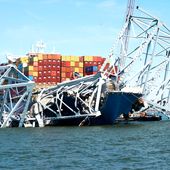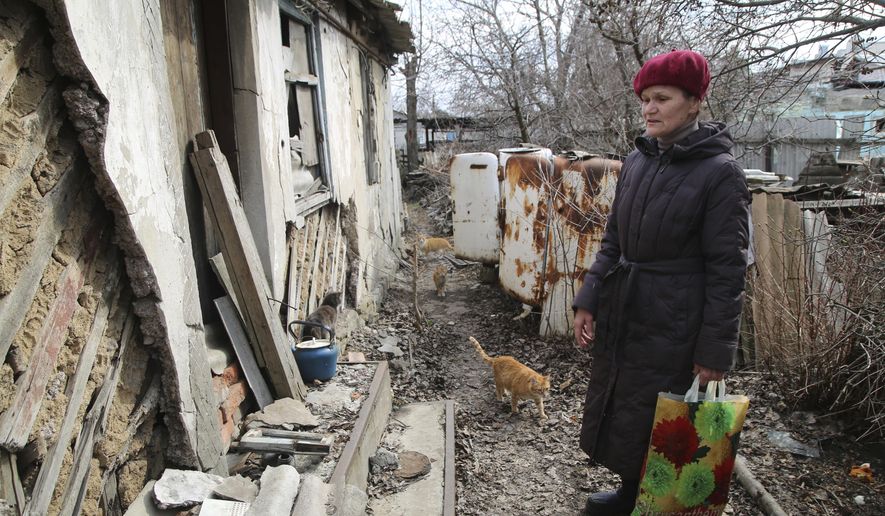NATO leaders and Russia traded sharp threats Tuesday over a military standoff in Ukraine, with President Biden pressing the Kremlin to de-escalate the situation and suggesting it was time for him and Russian President Vladimir Putin to have a face-to-face talk about Russian provocations.
Fears mounted over a sharp Russian buildup of troops and naval assets on Ukraine’s perimeter in recent days. Analysts said it could be a move to support more openly pro-Russian separatists in eastern Ukraine who have been battling the Western-supported government in Kyiv. Russia’s defense minister said some 40,000 troops near Ukraine’s eastern border were on a training exercise and accused the U.S. and its allies of beefing up their own forces along Russian borders in recent months.
More than 14,000 people have died in fighting in eastern Ukraine, and a European-led series of peace talks has made little evident progress. Ukraine has issued daily reports of military casualties over the past week, and rebels also have suffered losses, The Associated Press said.
Mr. Biden emphasized what he said was Washington’s unwavering commitment to Ukraine and called on the Russian president to dial back his buildup of forces along the Ukrainian border. White House officials said Mr. Biden also proposed a face-to-face meeting with Mr. Putin in a third country over the “coming months” to talk through a range of other U.S.-Russian friction points.
The Kremlin acknowledged the summit offer and told reporters in Russia that Mr. Putin had outlined for Mr. Biden his own vision for a political settlement to the Ukrainian crisis, the Tass news agency reported. Ukrainian separatists have been demanding a far higher level of local autonomy for the country’s Russian-speaking population than Kyiv has been willing to accept.
There was no immediate sign of a breakthrough on Ukraine as Mr. Biden’s high-stakes phone diplomacy coincided with a flurry of activity at NATO headquarters in Brussels, where Secretary of State Antony Blinken and Defense Secretary Lloyd Austin met with their Western European counterparts to discuss options for countering the Russian provocations.
SEE ALSO: Russian provocations surging as Blinken and Austin huddle with NATO allies
“We’re now seeing the largest concentration of Russian forces on Ukraine’s border since 2014,” Mr. Blinken told reporters before heading into talks with Ukrainian Foreign Minister Dmytro Kuleba. “[It] is of deep concern not only to Ukraine, but to the United States, and indeed to many of our allies and partners.”
NATO Secretary General Jens Stoltenberg said Moscow must dial back its “unjustified” military provocations, which he said amount to “the largest massing of Russian troops since the illegal annexation of Crimea in 2014.”
“Over the last days, several Ukrainian soldiers have been killed in eastern Ukraine,” Mr. Stoltenberg said. Russia “must end this military buildup in and around Ukraine, stop its provocations and de-escalate immediately.”
The view from Moscow
Russian Defense Minister Sergei Shoigu offered a sharply different take on the crisis by blaming the U.S. and its allies for the increased tensions. Moscow has argued that movements of Russian troops within its own borders are internal affairs.
Speaking at a meeting with top Russian military officials, Mr. Shoigu said the drills were a response to what he claimed were continuous efforts by the United States and its NATO allies to beef up their forces near Russia’s borders from the Baltic region in the north to the Black Sea.
In the past three weeks, the Russian military has deployed two armies and three airborne formations to western regions “as a response to the alliance’s military activities threatening Russia,” Mr. Shoigu said, although he described the Russian moves as part of readiness drills that would last another two weeks.
Amid the tensions, the United States has notified Turkey that two U.S. warships would sail to the Black Sea on Wednesday and Thursday and stay there until May 4 and May 5. The move is expected to further rankle the Kremlin.
“The United States is our adversary and does everything it can to undermine Russia’s position on the world stage,” Deputy Foreign Minister Sergei Ryabkov told Russian reporters Tuesday in some of the sharpest rhetoric to date from the Kremlin.
“We warn the United States that it will be better for them to stay far away from Crimea and our Black Sea coast,” Mr. Ryabkov said. “It will be for their own good.”
Analysts have told The Washington Times that the Russian president has been ramping up “hybrid warfare” operations in Ukraine and in the Arctic during recent weeks in an early test of Mr. Biden’s resolve.
“The Kremlin is testing Biden in a couple of places right now. That’s what the Kremlin does. It tests new presidents,” Donald N. Jensen, a former U.S. diplomat and member of the Russia and Strategic Stability project at the United States Institute of Peace, said in an interview last week. The Ukraine situation has added urgency to a tense dynamic.
Russian-baсked separatists and Ukrainian forces have been locked in a conflict in eastern Ukraine since Moscow’s annexation of the Crimean Peninsula from Kyiv seven years ago. More than 14,000 people have died in fighting in eastern Ukraine, and efforts to negotiate a political settlement have stalled.
Meanwhile, the Biden administration is attempting to show strength against Russia after years of friction stemming from American intelligence community assessments of Russian meddling in U.S. elections and rampant cyberhacking targeting U.S. information networks.
In addition to leveling human rights abuse sanctions against Moscow in March over the suspected poisoning and then jailing of Russian opposition leader Alexei Navalny, the administration prompted outrage at the Kremlin by ramping up diplomatic efforts to halt construction of Russia’s Nord Stream 2 gas pipeline to Germany.
Mr. Biden made the positive move of extending the expiring New START nuclear deal with Moscow, but he followed up by endorsing in an interview the view that Mr. Putin is a “killer.”
Some analysts say the administration should consider taking more of a transactional stance and that the White House may be able to resolve the Ukraine tensions quickly by easing off its efforts to halt Nord Stream 2.
“The Russian-led conflict in eastern Ukraine’s Donbas region and the construction of the Nord Stream 2 gas pipeline from Russia to Germany are the two most contentious issues on the Euro-Atlantic security agenda today,” said retired U.S. Foreign Service Officer Colin Cleary.
“Each is at a dangerous impasse. Linking the two would broaden the space for negotiation and provide opportunities for potential trade-offs,” Mr. Cleary, a former State Department director for energy diplomacy for Europe, said in an analysis published Tuesday by the Atlantic Council. “This could lead to a resolution that would be in the interest of all parties.”
Although Biden administration officials are believed to be carefully weighing such thinking, there is little sign that the president is eager to back off from efforts to halt Nord Stream 2, a pipeline that experts say would dramatically increase the European Union’s energy dependency on Russia.
A summary of Mr. Biden’s call to Mr. Putin that the White House circulated Tuesday did not mention Nord Stream 2.
“President Biden reaffirmed his goal of building a stable and predictable relationship with Russia consistent with U.S. interests,” said the summary, adding that Mr. Biden “proposed a summit meeting in a third country in the coming months to discuss the full range of issues facing the United States and Russia.”
⦁ Seth McLaughlin contributed to this article, which is based in part on wire service reports.
• Guy Taylor can be reached at gtaylor@washingtontimes.com.




Please read our comment policy before commenting.